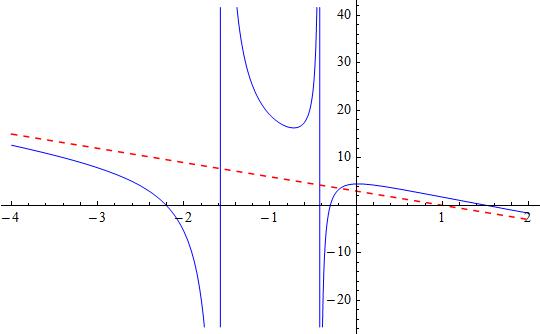In a polynomial fraction #f(x) = (p_n(x))/(p_m(x))# we have:
#1)# vertical asymptotes for #x_v# such that #p_m(x_v)=0#. Here #x_v = {1/3 (-3 - sqrt[3]), 1/3 (-3 + sqrt[3])}#
#2)# horizontal asymptotes when #n le m#
#3)# slant asymptotes when #n = m + 1#
In the present case we dont have vertical asymptotes and #n = m+1# with #n = 3# and #m = 2#
Slant asymptotes are obtained considering #(p_n(x))/(p_{n-1}(x))
approx y = a x+b# for large values of #abs(x)#
In the present case we have
#(p_3(x))/(p_2(x)) =(-9 x^3 - 9 x^2 + 28 x + 9)/(3 x^2 + 6 x + 2)#
#p_3(x)=p_2(x)(a x+b)+r_1(x)#
#r_1(x)=c x + d#
#-9 x^3 - 9 x^2 + 28 x + 9 = (a x + b) (3 x^2 + 6 x + 2) + c x + d#
equating coefficients
#{
(9 - 2 b - d=0), (28 - 2 a - 6 b - c=0), (9 + 6 a + 3 b=0), (9 + 3 a=0)
:}#
solving for #a,b,c,d# we have #{a = -3, b = 3, c = 16, d = 3}#
substituting in #y = a x + b#
#y = 3 - 3 x#
Note that
#(p_3(x))/(p_2(x))=(a x+b)+(r_1(x))/(p_2(x))#
and as #abs(x) # increases #(r_1(x))/(p_2(x))->0#
Attached a figure showing the results.



